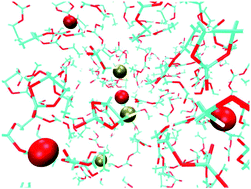Computer simulation study of the solvation of lithium ions in ternary mixed carbonate electrolytes: free energetics, dynamics, and ion transport
Abstract
A ternary mixture of ethylmethyl carbonate (EMC), dimethyl carbonate (DMC), and ethylene carbonate (EC) is a common solvent used in lithium ion batteries. The effect of cyclic ethylene carbonate (EC) on the solvation structure, free energetics and related dynamics of the ternary mixed carbonate electrolyte with lithium hexafluorophosphate (Li+PF6−) salt is systematically investigated by molecular dynamics simulations. The EC co-solvent tends to decrease the structural heterogeneity and solvent fluctuation in the solvation of Li+ ions. Despite the large difference in dielectric constants according to the EC concentration, the effective polarity of ternary mixed electrolytes, measured as the solvation-induced stabilization of Li+ ions, is marginally affected by EC co-solvent. As the EC concentration χEC increases, the solvation structural relaxation of Li+ ions accelerates in the subpicosecond regime, whereas the diffusional motion of ions slows down. The viscosity of the electrolyte solution and the solvation structure changed by EC co-solvent contribute to the ionic conductivity in an opposite manner, and as a result, the ionic conductivity of the electrolyte solution exhibits non-monotonic behavior according to χEC.



 Please wait while we load your content...
Please wait while we load your content...